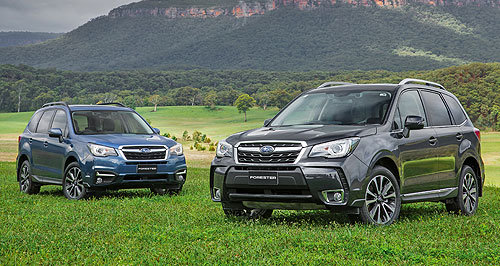Driven: Updated Subaru Forester checks in
BY DANIEL GARDNER | 25th Feb 2016

Headlining the 2016 Forester is its mild facelift which brings a new re-sculpted front bumper to all but the top-spec XT variants, a new-look grille, headlights with C-shaped LED daytime running lights and fresh foglight surrounds for the higher-end versions.
At the back end, the update is limited to a new tail-light design, which incorporates C-shaped LED lighting to match the new headlight design.
For 2.5i-S, XT and XT Premium variants, the Forester also gets Steering Responsive LED headlights to focus the whiter beam around corners as the steering is turned.
A new Sepia Bronze Metallic paint option and new 17-inch and 18-inch alloy wheel designs complete the exterior revamp.
On the inside the Forester offers a more comfortable place for occupants with enhancements made to noise, vibration and harshness levels (NVH) such as quilting on door trims, thicker seat cushioning and window glass, and padding added to either end of the instrument panel.
A more aerodynamic wheel design and engine under-body panelling cuts turbulence to reduce wind noise, as well as increasing fuel-efficiency. Subaru estimates the NVH reduction to be in the region of five per cent.
While all variants except i-L Foresters get the company’s acclaimed EyeSight stereoscopic camera safety tech, Subaru says it will respond to customer demand for a more accessible version with a new EyeSight Special Edition on the way soon.
NVH levels have been further reduced by a retune of the Forester’s chassis, which has also improved the handling and road manner, according to Subaru.
Following the model’s launch in Australia, Subaru’s local engineering team fettled the suspension with different damper and spring rates, as well as new mounting bushes to hone the Forester’s handling for local roads and conditions.
Rear suspension geometry has been redesigned for better straight-line stability.
A new steering box has reduced the Forester’s rack ratio down from 15.5:1 to 14:1 for greater feel and reduced turns from lock to lock, but also reduces felt vibrations, says Subaru.
The XT Premium has been treated to Vehicle Dynamics Control (VCD) torque vectoring, which applies inside wheel brake force in fast cornering to mitigate understeer.
As far as the rest of the Forester’s specification goes, it is business as usual with the powertrain and variant line-up unchanged.
Base 2.0i-L Foresters are available with a manual gearbox only and with the 2.0-litre horizontally opposed petrol engine, producing 110kW and 198Nm finding all four wheels via Subaru’s synonymous symmetrical all-wheel drive system and a six-speed self-serve box.
Fuel consumption is the best of the petrol Foresters, with 7.2 litres consumed per 100km on the combined cycle.
Moving up to the 2.5i-L and 2.5i-S brings an extra 0.5-litres of capacity to the naturally aspirated boxer-four engine and a corresponding 126kW/235Nm. The 2.5-litre is only available with a continuously variable transmission (CVT) and burns through 8.1L/100km.
The 2.0-XT Forester variants have a turbo added to the 2.0-litre four-cylinder, pumping petrol power up to 177kW and 350Nm. Fuel consumption is rated at 8.5L/100km.
While the i-L and XT 2.0-litre petrol engines differ in capacity by just three cubic centimetres, the naturally aspirated boxer has an undersquare stroke ratio for more low-down torque, while the turbo version has a relatively unusual square ratio for a balance of free-revving power and torque.
The Forester’s only diesel option matches the turbo XT for torque, but forfeits some power with a maximum of 108kW at 3600 rpm. The 2.0D-L and 2.0D-S are economy champs of the range though, posting a figure of 6.3L/100km for the automatic, or 5.9L/100km when paired with a manual gearbox.
The i-L and D-L variants share equipment levels with a 7.0-inch touchscreen and Pandora, USB and Bluetooth compatibility in addition to the driver’s Multi-information display and Multi-function display, idle-stop, leather steering wheel and 60:40 split rear seating.
Safety gets a good look in with Isofix child seat anchors, reversing camera, seven airbags including full-length curtain, seatbelt warning for all five seats, shock-absorbing pedals for the driver, ESC, ABS and EBD with brake assist.
Wheels measure 17 inches while a roof spoiler, roof rails, chrome grille and colour-coordinated door mirrors with indicator repeaters are standard.
The 2.5i-L variants add to that list with paddle shifters for the CVT auto, sliding centre armrest, and Subaru’s X-Mode for displaying vehicle information when travelling off-road.
i-S versions generally align with D-S level cars with navigation, power tailgate, sunroof, Subaru’s EyeSight safety technology with autonomous braking, heated front seats, leather upholstery, rain-sensing wipers, keyless start and 18-inch wheels.
Stepping up to the XT adds three SI-Drive modes, sports pedals, but do not get the EyeSight technology, while the XT Premium sits at the top of the kit pack with EyeSight, keyless entry, Harman Kardon stereo, power adjustable front seats, de-icing wipers and mirrors.
2016 Subaru Forester pricing*
| 2.0i-L | $29,990 |
| 2.5i-L (a) | $32,990 |
| 2.5i-S (a) | $39,490 |
| 2.0D-L | $33,490 |
| 2.0D-L (a) | $35,490 |
| 2.0D-S | $39,490 |
| 2.0D-S (a) | $41,490 |
| 2.0XT (a) | $40,990 |
| 2.0XT Premium (a) | $47,990 |